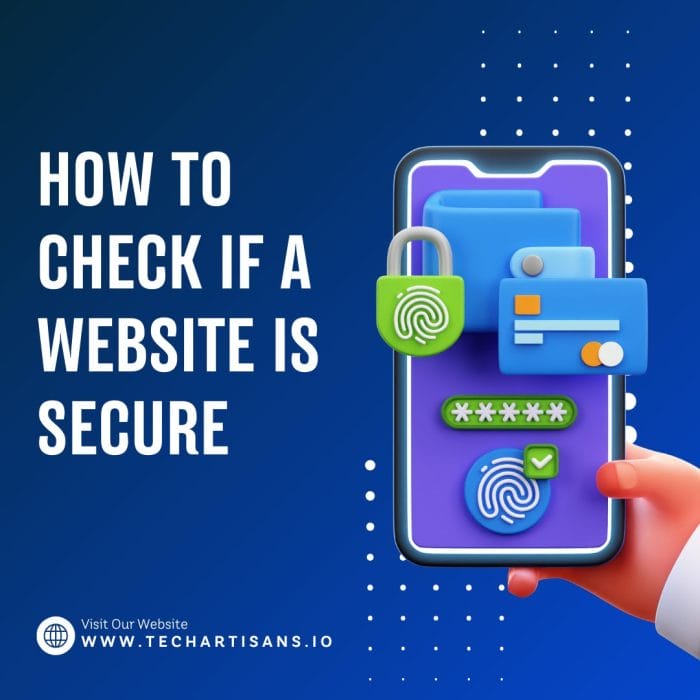In today’s digital era, every business owner must understand the importance of web security. As the proprietors of small to medium businesses, you are responsible to your enterprise and customers. In an age where cyber threats are rampant and evolving, knowing how to check if a website is secure is paramount. This blog educates you on identifying certain websites, protecting your business operations, and ensuring customer trust. With practical insights and easy-to-understand guidance, you’ll soon be adept at navigating the complex realm of web security.
Understanding Website Security
Web security acts as a protective shield for your online presence, safeguarding your website and its users from cyber threats. To fully comprehend how to check if a website is secure, one must first understand what website security entails and why it plays a crucial role in today’s digital landscape. Let’s delve into web security basics and explore its importance for businesses.
Explain What Website Security Means.
Website security refers to the precautions to secure a website from cyber attacks. It’s akin to a digital fortress, safeguarding your website’s data and users’ information from malicious threats. These measures include using secure protocols, implementing firewalls, and regularly updating website code and software.
Your website is not just a digital store; it’s a repository of valuable data hackers are eager to exploit. Thus, ensuring its security should be a top priority. Remember, a secure website is the first step towards building trust with your customers and protecting your business reputation.
The Consequences of Using Insecure Websites For Businesses.
Using insecure websites can have serious repercussions for businesses. Firstly, there’s the risk of data breach. Cybercriminals can exploit security vulnerabilities to steal sensitive customer details, leading to loss of trust and potential legal action. Secondly, if Google identifies your site as insecure, your search engine ranking may decrease traffic and potential revenue. Lastly, a cyber attack can disrupt your operations, causing downtime that directly impacts customer satisfaction and your bottom line. Remember, maintaining web security isn’t just about protecting data; it’s about safeguarding your business reputation and customer relationships.
Signs of a Secure Website
Before diving into the main indicators of a secure website, it is helpful to understand that these signs serve as safeguards to protect the site and its users from potential cyber threats. Recognizing these signs is a fundamental aspect of web security, allowing you to verify the safety of a website before sharing any sensitive information. Let’s unpack these signs and learn to check if a website is secure.
The Presence Of HTTPS and What It Signifies.
The presence of HTTPS in a website’s URL is a significant sign of security. The term HTTPS, which stands for Hyper Text Transfer Protocol Secure, encrypts data transmitted between your browser and the website, protecting it from interception by hackers. Seeing ‘https://’ before a web address indicates that the website has an SSL (Secure Sockets Layer) certificate, ensuring the integrity and confidentiality of data exchanged. In essence, HTTPS is a critical component of web security.
The Importance Of the Padlock Icon In the Address Bar.
The iconic padlock icon in the address bar is another key sign of a secure website. Displayed before the URL, this symbol indicates that the website uses encryption, meaning the data you share with the site is private. This padlock represents a secure connection between your browser and the website, affirming that your information is safe from prying eyes, a vital aspect of web security.
Security Certificates And Their Role In Website Security.
Security certificates, or SSL certificates, are crucial to website security. They authenticate a website’s identity and enable encryption of data transmitted between the server and the user. An SSL certificate is a website’s digital passport, signifying its legitimacy and safeguarding the interchange of sensitive information. In the context of web security, checking for the availability of a valid SSL certificate is a key step in determining a website’s security.
Using Security Tools and Browser Indicators
When preserving web security and knowing how to check if a website is secure, utilizing security tools and understanding browser indicators are invaluable practices. This section will delve into these tools and indicators, further equipping you to navigate the digital environment securely.
Using Browser Security Indicators (e.g., Google Chrome’s Security Features).
Google Chrome, among other browsers, offers built-in security features that can help verify a website’s security. To check, look for the padlock icon next to the URL in the address bar. A green padlock signifies that the website uses encryption, keeping your information secure.
Moreover, Chrome provides detailed security information about the site you’re visiting. Click on the padlock icon to access this. You’ll see whether the site has a valid SSL certificate and if cookies are used.
Additionally, Chrome warns users when they attempt to visit potentially unsafe websites, adding an extra layer of protection. Learning to interpret these browser indicators is key to maintaining web security.
Recommended Security Tools For Website Verification.
There are several security tools you can use to verify a website’s security:
1. SSL Server Test: This tool by Qualys SSL Labs gives an in-depth analysis of a website’s SSL configuration, helping you understand how secure the site’s connection is.
2. Google Safe Browsing: Google’s tool lets you check if a website has been identified as unsafe. Just type ‘google.com/safebrowsing/diagnostic?site=’ followed by the site URL.
3. VirusTotal: This tool analyzes websites through numerous antivirus engines and databases to detect potential threats. It’s a great way to double-check a site’s safety.
These tools can reinforce your efforts to maintain web security and ensure you interact with secure websites.
The Role of SSL Certificates
SSL Certificates are crucial in web security, functioning as digital passports for websites and establishing secure connections between browsers and servers. Let’s delve into their role and how they aid in ensuring a website’s security.
What is an SSL certificate?
An SSL (Secure Sockets Layer) Certificate is a digital document verifying a website’s identity and protecting communication between a web server and a browser. It uses encryption to secure sensitive data, such as credit card numbers or login details, from hackers intercepting it. This makes certificates a vital component of overall web security.
How SSL Certificates Protect Data.
SSL certificates protect data by encrypting the information sent from a user’s browser to the website’s server. When data is transmitted without encryption, it is vulnerable and can be intercepted by cybercriminals. However, using a key, an SSL certificate transforms any data transferred into an unfetchable format. Only the specific receiver can decrypt the data, ensuring it remains confidential and secure.
Evaluating Website Design and Structure
When determining how secure a website is, one often overlooked indicator is the website’s design and structure. A well-structured, professionally designed website usually signals a commitment to user security. Let’s explore how to evaluate a website’s design and construction in the context of web security.
The Correlation Between Modern Design and Security.
It’s no coincidence that modern, well-designed websites are more secure. This correlation stems from solid web design, which often goes hand-in-hand with advanced security measures. If a business invests in a sleek, user-friendly website design, it will likely prioritize web security. Moreover, modern web design standards promote secure coding, reducing potential vulnerabilities. In essence, a modern-looking website is often an indirect indication of stringent security measures, making it an important factor when learning to check if a website is secure.
Risks Associated With Outdated Themes And Plugins.
Outdated themes and plugins pose significant risks to web security. They may contain vulnerabilities that cybercriminals can exploit to gain unauthorized access or distribute malware.
Maintaining outdated plugins and themes is akin to leaving your doors unlocked in a neighborhood known for burglaries. It’s an open invitation for hackers looking for easy targets.
Furthermore, outdated elements can cause compatibility issues, leading to a poor user experience or website crashes. This could tarnish your website’s reputation and deter visitors.
In conclusion, regular updates are essential to ensure your website’s themes and plugins maintain the highest levels of web security.
Checking for Security Seals and Certifications
Security seals and certifications serve as a hallmark of trust and safety. Their presence indicates that a website has undergone rigorous security audits and adheres to best practices in web security. This section will discuss how to spot these seals and certifications to ensure the website you’re interacting with is secure.
Understanding Security Seals.
Security seals are visual indicators displayed on websites to signify that they have met specific security standards. They are often provided by third-party organizations specializing in web security, such as Symantec, McAfee, or Trustee. These badges indicate that the website proactively protects user data and can be trusted, playing a crucial role in customer confidence and online safety.
How To Verify The Authenticity Of Security Badges.
Security badges are not merely decorative but significant in proving a website’s safety. However, fraudsters may mimic these badges to mislead visitors. It’s important to verify their authenticity. Simply clicking on the badge should redirect you to the certifying authority’s page, detailing the security measures the website adheres to. This could be a red flag if the badge is non-clickable or leads to a general page instead of specific site security details.
Additionally, examining the URL can help. A secure website will always have a URL starting with “https://” and not ‘http://,’ the ‘s’ indicating a secure connection. Verifying these aspects ensures your interactions remain within the parameters of web security.
Investigating the Website’s Ownership
Gaining insight into a website’s ownership can provide information about its credibility and commitment to web security. This section investigates various methods of analyzing a website’s rights and how they contribute to ensuring a secure browsing experience.
Using WHOIS to Check Website Registration.
WHOIS is a tool that provides details about a website’s registration, including the owner’s name, organization, and contact information. By utilizing WHOIS, you can verify if the data aligns with what is presented on the website. Discrepancies in these details can signal potential threats to web security, making WHOIS a valuable resource for learning how to check if a website is secure.
The Importance of Knowing Who Owns the Website.
Understanding who owns a website can be crucial in assessing its security. If the owner is a reputable individual or organization, it can lend credibility to the site and assure its safety. Conversely, a less transparent or unknown owner might indicate potential security risks. Hence, investigating the website’s ownership is crucial in understanding how to check if a website is secure.
Recognizing and Avoiding Spam Indicators
Spam indicators are common red flags that suggest a website may not be safe to visit or interact with. In the next section, we will explain how to recognize and avoid these indicators, further enhancing your knowledge of web security and helping you understand how to check if a website is secure.
Common Spam Indicators on Websites.
One common spam indicator is excessive pop-up advertisements, often intrusive and unrelated to the website’s content. Other indicators include unsolicited requests for personal information, poorly written text riddled with grammar errors, and a lack of secure connection, identifiable by the URL’s absence of ‘https://.’ These red flags and an unprofessional design can hint at a website’s need for more commitment to web security.
Tips to Avoid Spammy and Potentially Insecure Websites.
Avoiding spammy and potentially insecure websites can be achieved by being vigilant about the red flags mentioned earlier. Always check for a secure connection (https:// in the URL), and avoid websites with excessive pop-ups and requests for personal information. Review the website’s content quality and professionalism, and use tools like WHOIS to verify website ownership. Familiarizing yourself with these strategies will significantly enhance your web security.
Practical Steps to Check a Website’s Security
Let’s explore practical steps that you can take to check a website’s security. This practical guide empowers you to confidently navigate the digital space, knowing that you are taking appropriate measures to ensure your online safety and uphold web security principles.
A Step-by-Step Guide
- Check for HTTPS: Ensure the website’s URL begins with ‘https://’ and not ‘http://,’ where ‘s’ signifies a secure connection.
- Verify Security Seals: Look for security badges from reputable companies like Symantec, McAfee, or Truste, and verify their authenticity by clicking on them.
- Use WHOIS: Utilize the WHOIS tool to check website registration details and confirm the owner’s credibility.
- Identify Spam Indicators: Be alert for spam indicators like excessive pop-ups, unsolicited personal information requests, and poor content quality.
- Avoid Potential Risks: Avoid websites exhibiting spam indicators and prioritize web security when browsing online.
Additional Tips for Non-Technical Business Owners.
Maintaining web security only sometimes requires in-depth technical knowledge. As a business owner, simple practices can greatly enhance your online safety.
- Regular Updates: Keep your browser and system updated regularly. These updates often include security enhancements to combat emerging threats.
- Strong Passwords: Implement strong, unique passwords across your accounts and encourage your team to do the same.
- Educate Your Team: Educate your employees about basic security measures, such as not clicking on suspicious links or sharing sensitive data.
- Invest In Security: Consider investing in reputable antivirus software and a reliable firewall for additional protection.
Remember, the first step towards web security is remaining vigilant and informed.
Conclusion
In conclusion, understanding how to check if a website is secure is crucial to maintaining web security. For businesses, this is not just about protecting the company’s information but also safeguarding customer data, reinforcing trust, and enhancing your brand’s reputation. It’s crucial to be proactive, employing simple yet effective measures like regular updates, strong passwords, and investing in reliable security tools. You can navigate the digital space confidently and securely by staying informed and vigilant. Remember, web security is not a one-time effort but a continuous process of adapting to evolving threats.







